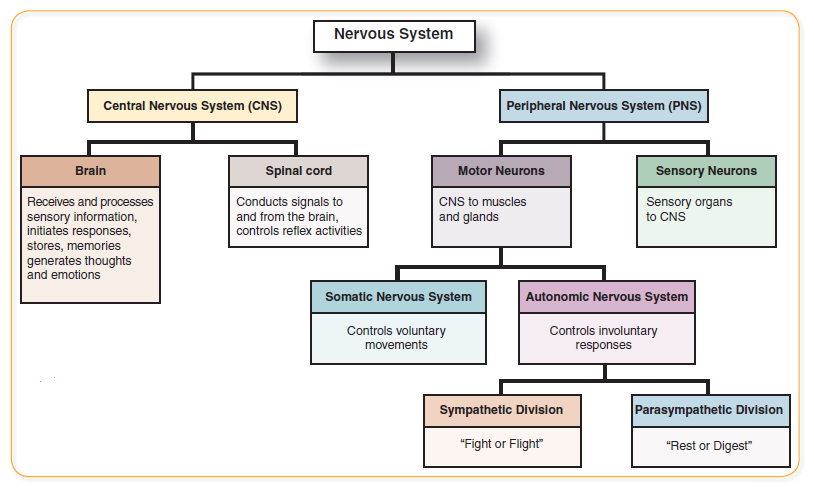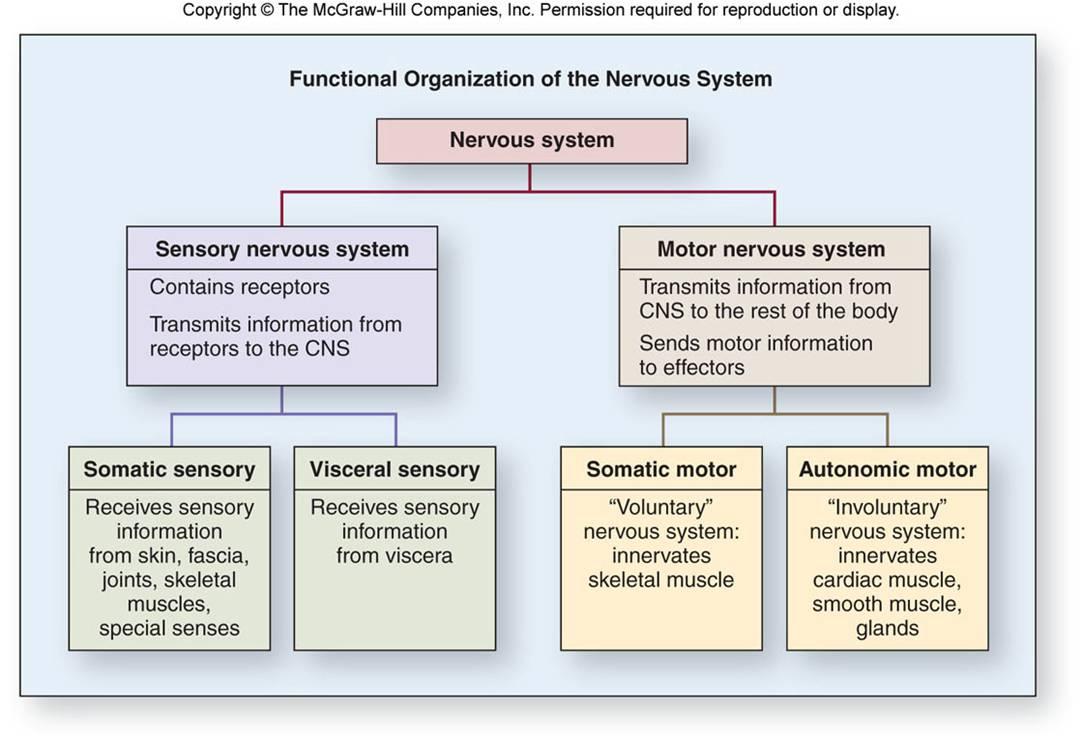It is further subdivided into the somatic nervous system SNS and the autonomic nervous system ANS. The sympathetic and parasympathetic divisions.

What Is The Function Of The Sensory Division Of The Peripheral Nervous System Study Com
The human nervous system consists of.

. The two functional subdivisions of the PNS are the afferent sensory division and the efferent motor division. The CNS contains the great majority of neuronal cell bodies and is divisible into the spinal cord and the brain. Describe the two divisions that make up the nervous system.
Central nervous system CNS is the integration and command center of the body Peripheral nervous system PNS represents the conduit between the CNS and the body. What is the difference. The central nervous system- consists of the brain and spinal cord.
Functional Division of the nervous system. The peripheral nervous systemconsists of the vast network of nerves throughout the body. The nervous system is mainly divided into central nervous system peripheral nervous.
Ganglia are collections or small knots of nerve cell bodies outside the CNS. The CNS performs integrative and control functions. The nervous system consists of two divisions.
The structures of the nervous system are described in terms of 2 principal divisions-the central nervous system CNS and the peripheral nervous system PNS. The CNS brain and spinal cord interprets incoming sensory information and issues instructions based on past experience. Central and peripheral somatic and autonomic.
The CNS is the brain and spinal cord. The peripheral nervous system is made up of nerves that branch off from the spinal cord and extend to all parts of the body. The central nervous system is made up of the brain and spinal cord.
- quickly prepares body for action - fight or flight eg. If you search divisions of the nervous systems under Google images you are provided with an endless array of graphs like the one I posted all with slightly different approaches to the same. For convenience the nervous system can be divided into two major divisions.
The CNS brain and spinal cord interprets incoming sensory information and issues instructions based on past experience. The nervous system can be divided into two functional parts. Central Nervous System CNS and Peripheral Nervous System PNS.
The central nervous system CNS consists of the brain and spi-nal cord. Human nervous system is mainly divided into 3 divisions which are as follows. The somatic nervous system causes contraction of.
Central nervous system CNS the brain and spinal cord. The peripheral nervous system PNS consists of all the nervous tissue outside the CNS nerves and ganglia. The nervous system has two main parts.
The somatic nervous system and the autonomic nervous system. The Divisions of the Nervous System. Describe how the Na-K ATPase pump works.
The somatic division receives information from skin skeletal muscles joints and special sense organs. Peripheral nervous system nerve cells that carry information to or from the CNS. Central and Peripheral Brain -controls most systems in the body -directs a response after receiving an impulse -sends it back through the spinal cord and out to the peripheral nervous system Spinal Cord -thick column of nervous tissue -vertebral column surrounds and protects it.
Up to 10 cash back The nervous system has two major divisions. The system is divided into the central nervous system or CNS that consists of the brain and spinal cord and the peripheral nervous system or PNS that is made up of nerves that travel to and from the central nervous system. The peripheral nervous system is further divided into the somatic nervous system and the autonomic nervous system.
Describe the basic parts of a neuron and what. What are the 2 divisions of the nervous system. Even though the brain and spinal cord are.
The anatomical divisions are the central and peripheral nervous systems. The transporter with an associated molecule of ATP binds 3. Central Nervous System 2.
Somatic sensory fibers transmit impulses from the joints skeletal muscles and skin. The human nervous system gathers information processes that information and then initiates a response. Each spinal nerve then divides into two branches called posteriordorsal and anteriorventral rami.
The somatic nervous system and the autonomic nervous system. Nerves are bundles of nerve fibers much like muscles are bundles of muscle fibers. The PNS is everything else and includes afferent and efferent branches with further subdivisions for somatic visceral and autonomic function.
The autonomic nervous system has two divisions. The cen-tral nervous system and the peripheral nervous system figure 81. The nervous system can be separated into divisions on the basis of anatomy and physiology.
The structures of the nervous system are described in terms of 2 principal divisions-the central nervous system CNS and the peripheral nervous system PNS. Increase heart rate dilating blood vessels. The nervous system transmits signals between the brain and the rest of the body including internal organs.
The major differences between the two systems are evident in the responses that each produces. Central Nervous System. There are several divisions of the nervous system well laid out in the graph above.
Somatic neurons carry signals that allow the CNS to consciously monitor the external environment and control body movements. The afferent division carries impulses toward the CNS from the bodys sensory receptors. Peripheral Nervous System 3.
The organs of the peripheral nervous system are the nerves and ganglia. The nervous system can be divided into two functional parts. Parasympathetic division - The part of the autonomic nervous system originating in the brain stem and the lower part of the spinal cord that in general inhibits or opposes the physiological effects of the sympathetic nervous system as in tending to stimulate digestive secretions slow the heart constrict the pupils and dilate blood vessels.
Cranial nerves and spinal nerves extend from the CNS to peripheral organs such as muscles and glands. The central nervous system and the peripheral nervous system. The PNS cranial and spinal nerves and ganglia provides the communication lines between the.
The major differences between the two systems are evident in the responses that each produces. The autonomic nervous system can then be divided into the sympathetic and parasympathetic branches. Most nerves are mixed meaning they contain both motor and sensory neurons.
This system is further divided into somatic and visceral divisions. Tahira Wynder Chapter 11-Nervous System Homework 1. The sensory system receives sensory information from receptors and transmits to the brain or spinal cord.
Based on their functions the neurons in nerves divide the peripheral nervous system into somatic and autonomic nervous systems. The nervous system can be divided into two major divisions. The somatic nervous system causes contraction of skeletal muscles.
Explain The Divisions Of Nervous System Sarthaks Econnect Largest Online Education Community

What Is The Function Of The Sensory Division Of The Peripheral Nervous System Socratic

What Are The Functional Divisions Of The Nervous System Socratic
Divisions Of The Nervous System Brooke Hamilton Neural Tissue
0 Comments